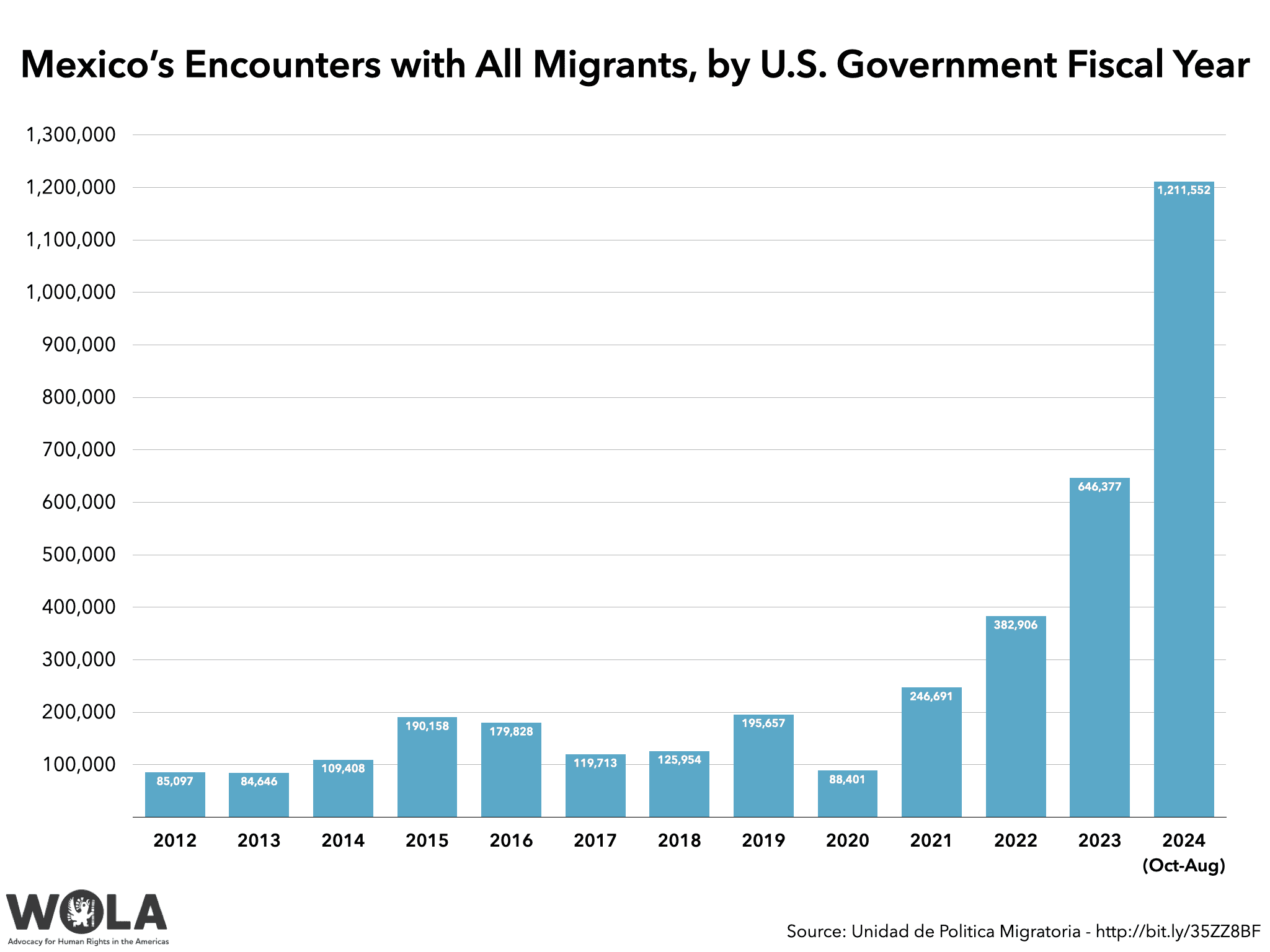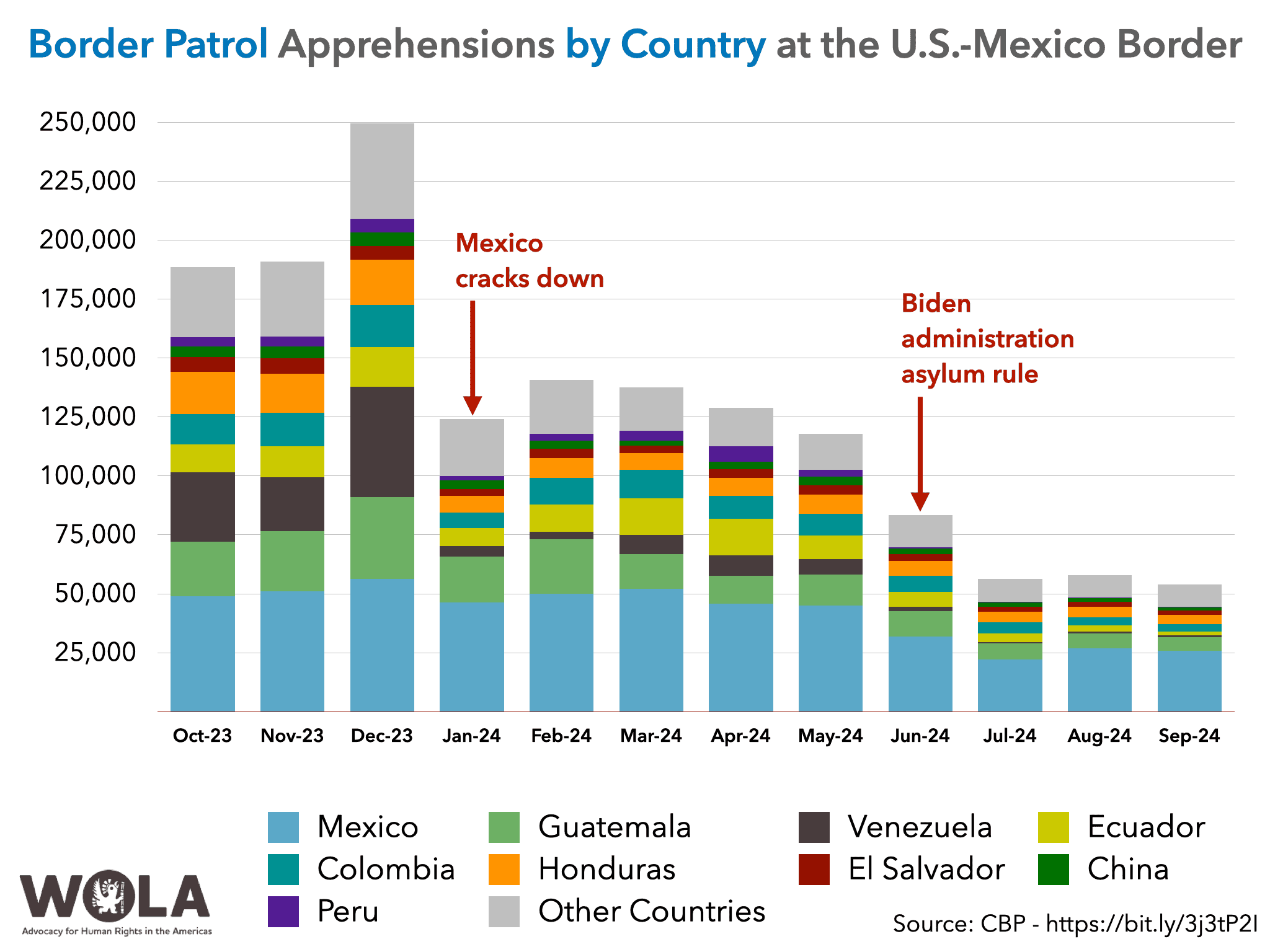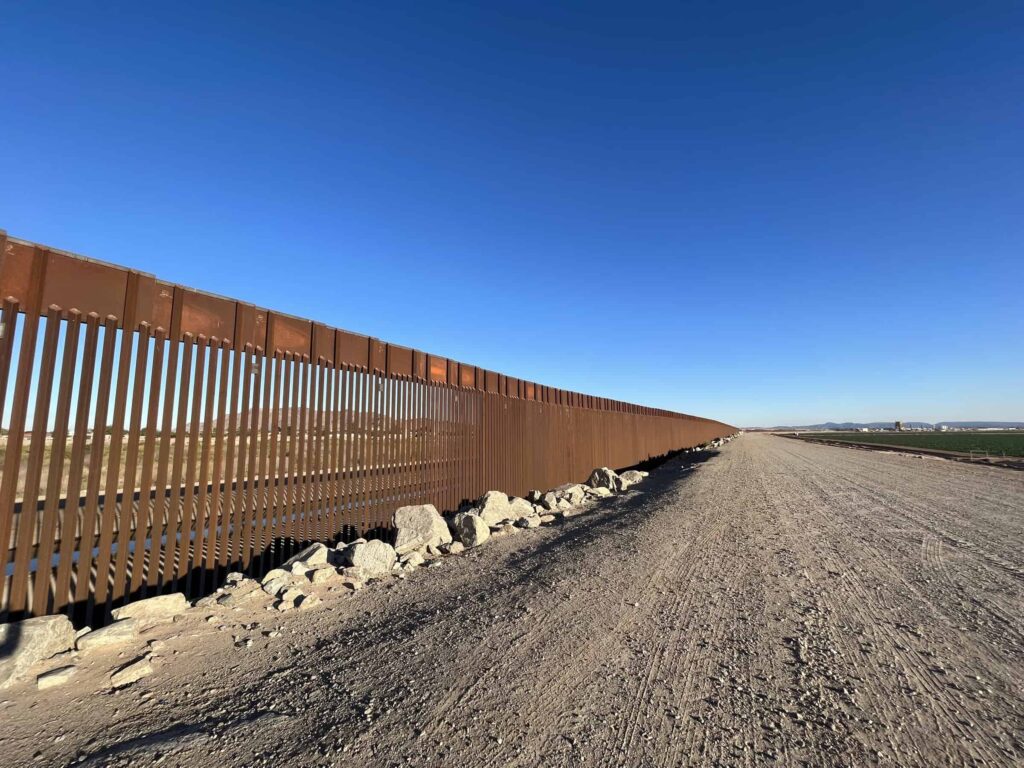Data table
Mexico – Starting in January, Mexico’s government stepped up its efforts to block migrants transiting the country’s territory from reaching the U.S.-Mexico border. Between January and August, Mexico reported encountering migrants 925,085 times, nearly triple the full-year total for 2022, which at the time was a record. Mexico has not detained or deported people heavily, choosing instead to transport tens of thousands of people to the southern part of the country, where many are awaiting appointments at border crossings using the U.S. government’s CBP One app.

United States – After Mexico’s crackdown cut Border Patrol’s apprehensions in half from December 2023 to January 2024, the Biden administration cut them in half again with a June proclamation and rule banning most access to the U.S. asylum system between ports of entry when numbers are high.

The administration’s asylum curbs led to a sharp drop (blue in the chart below, about -95 percent from December to September) in the number of asylum seekers released into the U.S. interior. The new procedure requires people to voluntarily express fear of return in order to start an asylum process, and usually to prove a higher standard of threat in an interview with an asylum officer shortly after arrival, often while in custody in expedited removal proceedings.
Combining Border Patrol and those at ports of entry, the nationalities most frequently encountered at the border in 2024 were Mexico (-9% from 2023), Venezuela (-2%), Guatemala (-7%), Cuba (+6%), Honduras (-34%), Colombia (-20%), Ecuador (+5%), Haiti (+16%), El Salvador (-12%), and China (+57%).
The crackdowns that reduced migration in 2024 have not been free of a painful human cost, as WOLA reported at the end of August:
the cost has been tens of thousands of people stranded in Mexico and untold numbers of people who need protection being denied it. Reports from non-governmental organizations and media, including two updates from coalitions of U.S. and Mexican groups, are documenting mounting abuses against people deported into Mexico, or enduring prolonged waits for CBP One appointments. These include rough treatment from U.S. and Mexican migration officials; family separations; kidnappings for ransom in Mexico; assaults and theft from criminals and corrupt officials in Mexico; racial, gender, and LGBTQ+ discrimination; squalid living conditions; denial of urgent health care; and increasing migrant deaths on U.S. soil.
Ample evidence points to this lull in migration being temporary, though that does not necessarily mean that migration will return to the record highs of late 2023:
From the past ten years of experience, we know that crackdowns bring only temporary drops in migration, as root causes persist and as some nationalities and demographics are less likely to be deported.
The reduction in migration brought by the Biden administration asylum rule has bottomed out, with Border Patrol apprehensions remaining between about 54,000 and 58,000 since July.
After notable declines from record levels in late 2023, the daily average of migration through Honduras and through Panama’s Darién Gap has inched upward since August 2024. A big reason is an increase in migrants leaving Venezuela after disastrous July 28 elections, when the sitting government refused to acknowledge an apparent opposition victory.
2. Children and families made up 43 percent of migrants encountered.
Of the 2,135,005 migrants encountered in 2024, 916,125 (43 percent) were children, or parents with children. The percentage was consistent for Border Patrol apprehensions alone, with 655,282 of 1,530,523 involving families. Forty-three percent represent the second-highest share since 2012, when family status records for Border Patrol apprehensions began to be publicly available, and is quite likely the second-highest ever.
The number-one year was 2019, during the Trump administration, when nearly two thirds of Border Patrol apprehensions were of family members and unaccompanied children, mainly from Central America.
In the intervening years (2020-2023), the Title 42 pandemic authority, which enabled U.S. authorities to rapidly expel migrants from the border over 2.9 million times, had the unintended effect of easing repeat border crossings for single adults, as “expelled” migrants were not punished for attempting new crossings. As single adults were more likely to attempt repeat crossings, their share of “migrant encounters” grew during the Title 42 period, while child and family migrants’ share shrank.
Since Title 42 ended in May 2023, there has been some reversion to the 2019 pattern. Single adults’ share of migration declined, while child and family migrants’ share increased. The top five nationalities of child and family migrants encountered in 2024 were Mexico, Venezuela, Guatemala, Honduras, and Colombia.
3. The geography of migration has undergone rapid post-pandemic shifts and moved west since the end of Title 42. Texas’s crackdown did not cause this.
Border Patrol divides the U.S.-Mexico border into nine sectors. Before the COVID-19 pandemic, one of these sectors would be migrants’ top destination for many years, leading all others in agents’ apprehensions. San Diego, California was number one from 1973 through 1997; Tucson, Arizona led from 1998 to 2012; Rio Grande Valley, Texas was first from 2013 through December 2021.
After the pandemic, the pattern changed dramatically. Since 2022 the identity of the number-one sector has changed every few months. Just since April 2023, the month before Title 42 ended, five of Border Patrol’s nine border sectors have been the busiest at different times.
Since July of last year, either Tucson or San Diego has been the number-one sector. That represents some westward movement in migration, as Texas’s Rio Grande Valley, Del Rio, and El Paso sectors had been in the lead earlier in the post-pandemic period.
It does not mean, however, that the Texas state government’s “Operation Lone Star” border crackdown is working. Since December 2023, the record month for Border Patrol migrant apprehensions, these have declined 78 percent border-wide. Texas does not stand out.
Texas (-86 percent) and Arizona (-85 percent) led the four U.S.-Mexico border states with almost identical rates of decrease from December to September. From January to September, Arizona has a steeper rate of decrease, and since May—that is, since the Biden administration asylum crackdown—California, too, has declined faster than Texas.
“Operation Lone Star” has cost over $11 billion and raised many human rights concerns, but has not deterred migration to Texas any more than to states where governments are not carrying out border crackdowns.
4. Migrant deaths may have declined. But deaths as a share of the migrant population have not.
A shocking number of migrants continue to perish on U.S. soil, usually from extreme heat or cold, dehydration, drownings, or falls from the border wall. Sometime in 2024, Border Patrol’s official count of migrant remains (which humanitarian workers say is an undercount) surpassed 10,000 for this century.
“Overall, southwest border deaths were down 30% comparing the fourth quarter of last fiscal year to this fiscal year,” CBP reported, without offering aggregate numbers for either summer. We know from secondary media reports that Border Patrol recovered 568 remains of migrants in fiscal 2021, 895 in 2022, 704 in 2023, and (as of September, according to CBS News) 560 in 2024. Agents in the El Paso Sector recovered the remains of at least 175 migrants during fiscal 2024, USA Today reported.
Though the overall number of deaths is down from the horrific high of 2022, it is similar as a proportion of the overall migrant population, as measured by Border Patrol apprehensions. Though the 2024 number is incomplete and may end up higher, for now it represents 37 migrant remains recovered per every 100,000 Border Patrol apprehensions, up somewhat from 2023 (34 per 100,000) and down slightly from 2022 (41 per 100,000).
5. Fentanyl seizures dropped for the first time. It’s not clear why.
Seizures of the potent opioid fentanyl fell for the first time since the drug began appearing. CBP seized 21,148 pounds of the drug in 2024, down from 26,718 pounds in 2023 (-26%).
The reduction is happening even as CBP has deployed more scanners and other technology to detect it, and carried out more targeted operations against smugglers.
A possible, but hard-to-prove, reason for the decline could have to do with shifting patterns in Mexican organized crime. Reports emerged in 2023 that Mexico’s Sinaloa Cartel, which controls much of the drug’s production, issued an order to cease production of the drug in Mexico’s Sinaloa state after the January 2023 arrest, and subsequent U.S. extradition, of Ovidio Guzmán, the son of former Sinaloa chief Joaquín “El Chapo” Guzmán. Some incidents in Sinaloa indicate that the cartel enforced this ban violently. Though fentanyl production has since increased in other Mexican states, this disruption may at least partially explain the 2024 drop in CBP seizures.
Similar to past years, 86.1 percent of 2024 fentanyl seizures occurred at official border crossings. Of the remaining 13.9 percent seized by Border Patrol, 4.5 percent was seized from vehicles at the agency’s interior checkpoints. Of those arrested for possessing fentanyl at ports of entry between 2019 and 2024, 80.2 percent were U.S. citizens, according to federal data obtained by the Cato Institute. There is no significant connection between migration and fentanyl smuggling.
Also similar to past years, 97 percent was seized in California or Arizona. “Half of the fentanyl coming into the U.S. is seized at the Mariposa Port of Entry” in Nogales, Arizona, CBP’s top official, Troy Miller, told the Arizona Republic.
Seizures of cocaine increased 10 percent, and methamphetamine increased 30 percent. Heroin fell 21 percent and marijuana 8 percent.
Conclusion
The 2024 decline in migrants arriving at the border may have decreased the salience of border security and migration in the U.S. election campaign, though they remain top issues. Still, the drop is a result of sharply limiting persecuted and threatened people’s ability to seek protection at the U.S.-Mexico border, and it is unlikely to be long-lasting.
Large numbers of people coming to the border are certain to remain a reality regardless of the U.S. election outcome. The experience of the past 10 years shows not only the futility of “crackdowns,” but the value of maintaining and expanding well-managed legal migration pathways. Those include work permits, humanitarian parole, a robust refugee resettlement program, family reunification and temporary protection programs, and a functioning asylum system with a restored right to seek protection at the border.
A better policy would strengthen those pathways as part of an overall, long-overdue immigration reform that would vastly reduce pressure on the border. It would be implemented by border management professionals who are held fully accountable when they violate human rights. It would be accompanied by a diplomatic and foreign assistance strategy that addresses the factors causing people to flee, eases other nations’ efforts to integrate migrants into their societies, and upholds reformers fighting corruption and communities fighting for dignified lives where they live now.
The past few years’ very modest progress toward this better policy should continue, rather than doubling down on enforcement efforts and limiting access to asylum.
Source link : http://www.bing.com/news/apiclick.aspx?ref=FexRss&aid=&tid=67348519ef74499bbb12b51f8487a2b5&url=https%3A%2F%2Fwww.wola.org%2Fanalysis%2Ffive-migration-and-security-trends-at-the-u-s-mexico-border%2F&c=17317203689154914812&mkt=en-us
Author :
Publish date : 2024-11-12 06:48:00
Copyright for syndicated content belongs to the linked Source.
